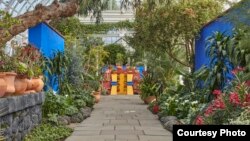In a sprawling, multi-disciplinary show, The New York Botanical Garden focuses on a long-overlooked side of artist Frida Kahlo: her deep connection to Mexico's plants and flowers, and how they inspired her art.
"Flora is a very important part of her creativity," said guest curator Ariana Zavala, a specialist in Mexican art and director of Latino Studies at Tufts University. Even those who thought they knew everything about Kahlo, Zavala said, will come away having learned something new.
The exhibit, "Frida Kahlo: Art, Garden, Life," includes 14 of Kahlo's original works; an evocation of the garden at her Mexico City home, Casa Azul (Blue House); plentiful photos from Kahlo's life; and various Mexican cultural offerings. It will be on view through Nov. 1.
A good place to begin is in the huge, glass Enid A. Haupt Conservatory, where the focus is on the gardens of Casa Azul, where Kahlo was born in 1907, lived for years with muralist Diego Rivera, and died in 1954. Pathways are lined with sunflowers, marigolds, fuchsia, palms, jacaranda, oleander, and numerous succulents and cacti, many of which still grow at Casa Azul, now a museum.
The lush, indigo-blue walls of Kahlo's home have been vividly rendered, as has her garden's Aztec-inspired pyramid, designed by Rivera, who painted it dazzling rose, blue and yellow. Here, it holds an array of native Mexican succulents and cacti in huge terracotta planters.
In researching the show, horticulturalists at the botanical garden, working with colleagues in Mexico and a longtime volunteer gardener at Casa Azul, came to understand Kahlo as an expert in plants, with an impressive botanical library. She replanted her parents' European-style garden with a mix of cacti and succulents, which she saw as symbolic of the native plants of Mexico, and with tropical plants, fruit trees, and other edible or medicinal plants.
"When we learned about Kahlo as a truly sophisticated gardener, who also happened to be a great artist and cultural icon, we were blown away," said Todd Forrest, the botanical garden's vice president for horticulture and living collections.
Over time, Kahlo transformed Casa Azul into an expression of her deep connection to the natural world and to Mexico.
Her studio overlooked the garden, and the plants came to play an important role in her art.
"As we studied Frida Kahlo through her plants, two important themes emerged: those of duality and of hybridity," Zavala said.
Both themes are illustrated in the 14 artworks on view at the garden's LuEsther T. Mertz Library art gallery. In Kahlo's 1931 "Portrait of Luther Burbank," the horticulturalist, whose garden she and Rivera had visited, is depicted as a hybrid plant-human. Kahlo, whose father was born in Germany and whose mother was Mexican, repeated this theme of hybrid origin in other works on view.
"Two Nudes in a Forest," painted in 1939, shows a light-skinned woman resting her head on a dark-skinned one. And in the 1940 "Self-Portrait with Thorn Necklace and Hummingbird," Kahlo, impassive and dressed in stark white, stares straight at the viewer while lush tropical vegetation and animals, including a black monkey and cat, surround her and appear to be on the verge of overtaking her.
In conjunction with the show, the garden is offering an array of cultural offerings to celebrate the artist.
"Frida liked to have fun. She had a love of life. This project is a celebration of Mexico," said Zavala. "In addition to taking in Frida's paintings and Frida's plants and what they meant to her, we hope people stay to enjoy some food and music from Mexico.''
There are Mexican cocktails and food; cooking lessons; textile demonstrations; music; an "Octavio Paz Poetry walk"; a native plant walk, and even a Mexican-themed puppet theater and "Frida's Kitchen" exhibit for kids.
Wall texts throughout the show are in Spanish and English.
New York Botanical Garden Preview of "Frida Kahlo: Art, Garden, Life"

